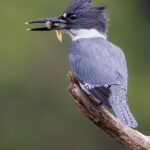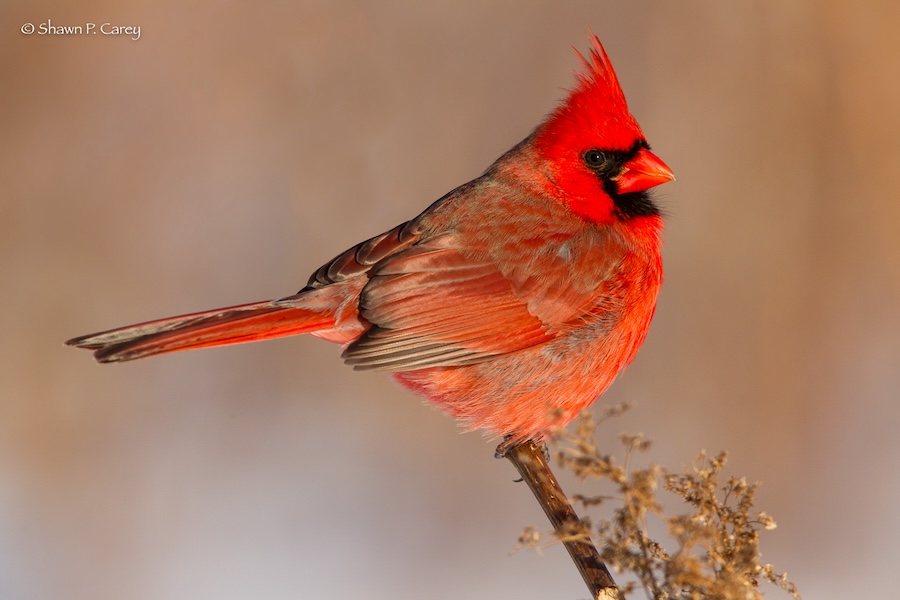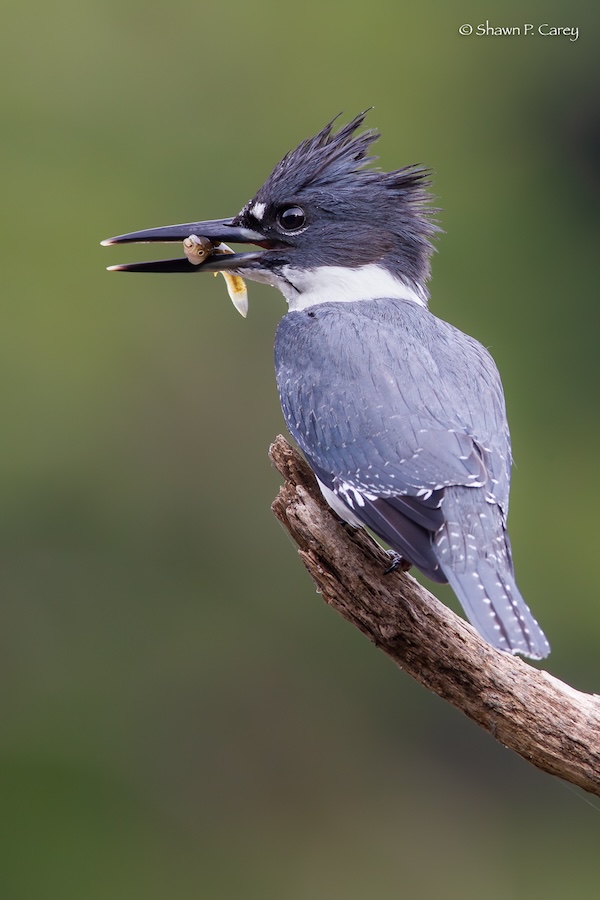
By Fred Bouchard
This is a selective survey of Belmont birds that you might observe in Belmont from October through December, or even into winter as our climate warms. Four arbitrarily selected environments highlight our tour: two of the town’s “birdier” (and, coincidentally, more visited) locales, Rock Meadow and Clay Pit Pond, Belmont Backyards, and Little Pond.
Rock Meadow: American Goldfinch, Northern Cardinal
These familiar endearing species share the common trait of sexual dimorphism: gals and guys don’t dress alike! Male goldfinches’ plumage shouts “yellow and black!” in the breeding season, when their conical seed-searching bills turn gray to pink, while females (and young males) sport a subdued lemony gray year-round. Cardinals, of course, hit the red spectrum—males tomatoey, females tawny buff-brown—though all adults have the signature crest, black face, and orange triangular bill.
Goldfinches are the brightest faces in a large family, including common streaky House Finches and rare buffy Pine Siskins. They bounce as they fly between flowers and weedy patches, flashing white wing bars, and their song bounces with them: ti-DI-di-di!
Cardinals are blushing starlets. While they prefer good cover in thickets, overgrown yards, gardens, and hedgerows, they amp up their brilliant whistle loud and clear: what-cheer-cheer-cheer!
These “permanent residents” are avid seed eaters. They haunt our cultivated gardens in summer and frequent our seed feeders (favoring nyger) and wild thickets off-season.
Belmont Backyards: White-breasted Nuthatch, White-throated Sparrow
In your yard, should you hear a dry, nasal “hneeh!” or “rank!” and spot a tidy gray/white critter with a black cap and a beady eye heading down a trunk, you’ve met your neighbor nuthatch. The Sitta family of North America has just five species, and our White-breasted is the biggest at 5 1/2 inches. They forage by inching down or along a branch for ants and grubs with a thick, slightly upturned bill. The smaller Red-breasted, with its pirate mask and squeaky “eek!”, stays high in conifers.
Nuthatches brace themselves not with their tails—as do woodpeckers and the related Brown Creeper, which faces up-trunk—but with strong claws strategically placed. These perky year-rounders gladly visit suet feeders and birdbaths.
There are “sparrows,” and there are sparrows. House Sparrows are, in fact, weaver finches, an Asian species introduced to North America around 1850 by nostalgic Europeans. Our commonest true sparrows—among 30-odd species nationally—are the permanent resident Song Sparrow and the migratory White-throated Sparrow. Close scrutiny helps distinguish these similar birds.
Song Sparrows are a bit smaller, slighter, and streakier, with idiosyncratic, multipart vocalizations. White-throats sport white throats and over-eye stripes, and often yellow lore (eye-to-beak) spots. Their voices tend to high, soft whistles and buzzy trills. We see them in spring and fall. Summers, they breed in the Berkshires and northward to Canada. They winter in our southern states and the Caribbean. Both sparrows scratch in garden beds and feeders, permitting your careful study.
Little Pond: Belted Kingfisher, Hooded Merganser
Sharp, dry rattles announce the arrival of a Belted Kingfisher, our daredevil aerial pond-side summer resident. At 13 inches, it’s mid-sized of three North American species, all with oversized heads and beaks and short legs and tails. They carve nests with dagger bills in mud holes, where they deposit and guard their eggs.
While Kingfishers may remain quietly watchful as they perch on overhanging branches, their fishing style is quite dramatic. They may hover before they dive straight down deep to spear fish, then rear back to swallow them whole. Comic, but impressive! Females and juveniles sport a second rusty “belt.”
Mergansers comprise our most distinctive family of ducks. They are unique crested hammerheads with long bodies, striking plumage, and razor-like serrated bills. They come in small (Hooded), medium (Red-breasted, only found in salt water), and large (Common).
Common Mergansers congregate in flocks on migration. I’ve seen 50 at Clay Pit and over 100 on the Mystic Lakes; their pure-white broadsides present a formal naval flotilla.
Since Hooded Mergansers prefer family (5–10) groups, they often maneuver into cozier waters. They’re dependable at Blair Pond and Black’s Nook off Fresh Pond. Spring courtship displays can bedazzle with erected crests and head-bobbing with gentle purrs. They migrate between the Caribbean and Eastern Canada.
Clay Pit Pond: Northern Mockingbird, Great Blue Heron
America’s finest avian mimic has been nesting annually at Clay Pit for decades. Mockingbirds flash their long, white-banded wings and make a bewildering hullabaloo with a lightning-fast mix-tape of nasal im-bird-onations.
Their elaborate sequences imitate—or ward off—neighboring species like jays, cardinals, wrens, and titmice. Their songs may be delivered from a prominent tree-top or guy-wire or deep in a holly bush or sumac stand as they protect a nest or guard a food stash.
Male mockers repeat and vary song snippets in random order and may sing day and night. They might even toss off a cell phone ringtone. Birdsong expert Don Kroodsma tallied one backyard Bocelli warbling 465 snippets in 26 minutes!
Fellow mimics, more original but far less prolific—the summer garden skulker Gray Catbird and dune-top repeater Brown Thrasher—have long since flown south. Mockers stick year-round. Sexes are “conspecific” (look-alike), but it’s the guys that vocalize, if much less, in darker months.
Majestic and graceful, sentinel-erect pondside or tree-roosting, he’s an iconic, pterodactylic silhouette in the sky . . . The Great Blue Heron (GBH) is our largest (4’4”) and heaviest (5+ pounds) of a dozen herons/egrets.
Can each of us recount a Great Blue Moment? Here’s mine: I’m crouching along a sheltered edge of Brookline’s Hall’s Pond boardwalk, watching a GBH stealthily stalk a small amphibian (Green Frog?) Intent on his prey, the lanky giant readies for the kill. His eye only suddenly shifts in my direction—he pauses mid-step. A tense moment: strike or flee? His strike goes awry, the frog dives; with a startled “gronk!” he flaps away gracefully, launches into the air, circles, and lands on an overhanging roost.
At Clay Pit Pond, GBHs prefer the semi-cover of the Underwood Street island. On migration, they also frequent Blair Pond and Little Pond.
Fred Bouchard is a member of the BCF Newsletter Committee




Sorry, the comment form is closed at this time.